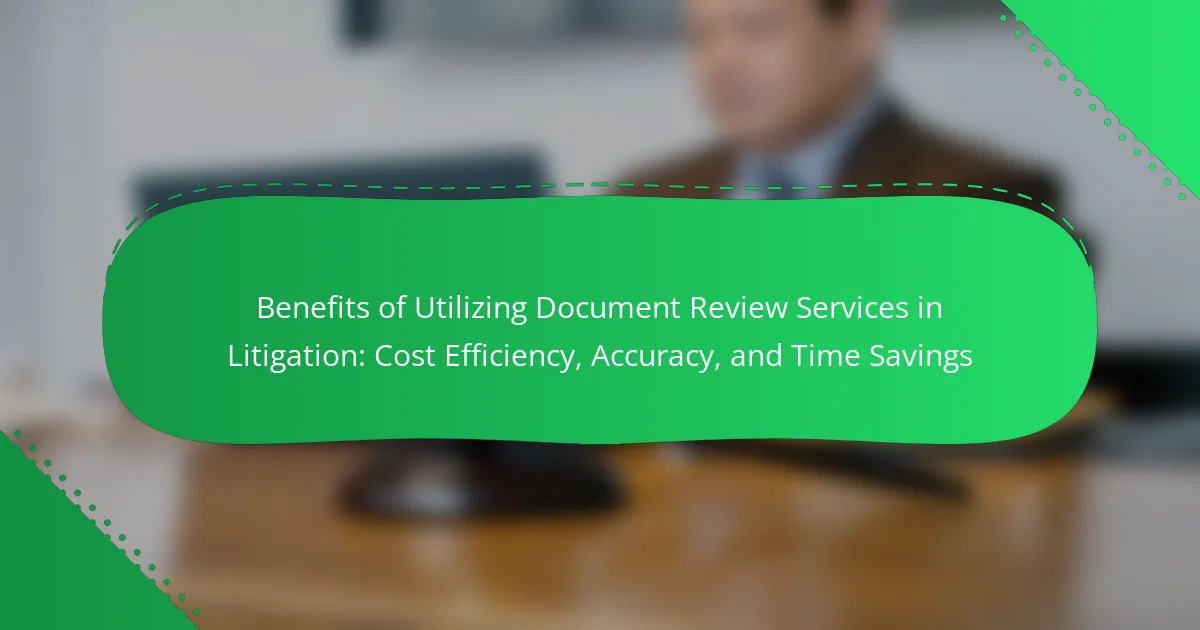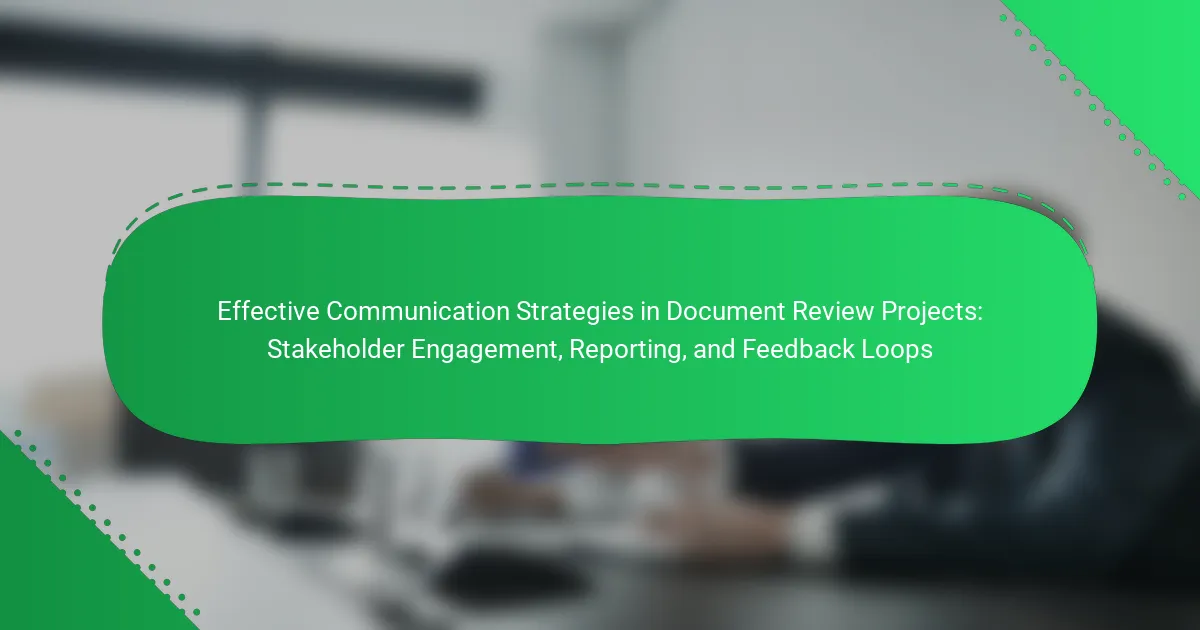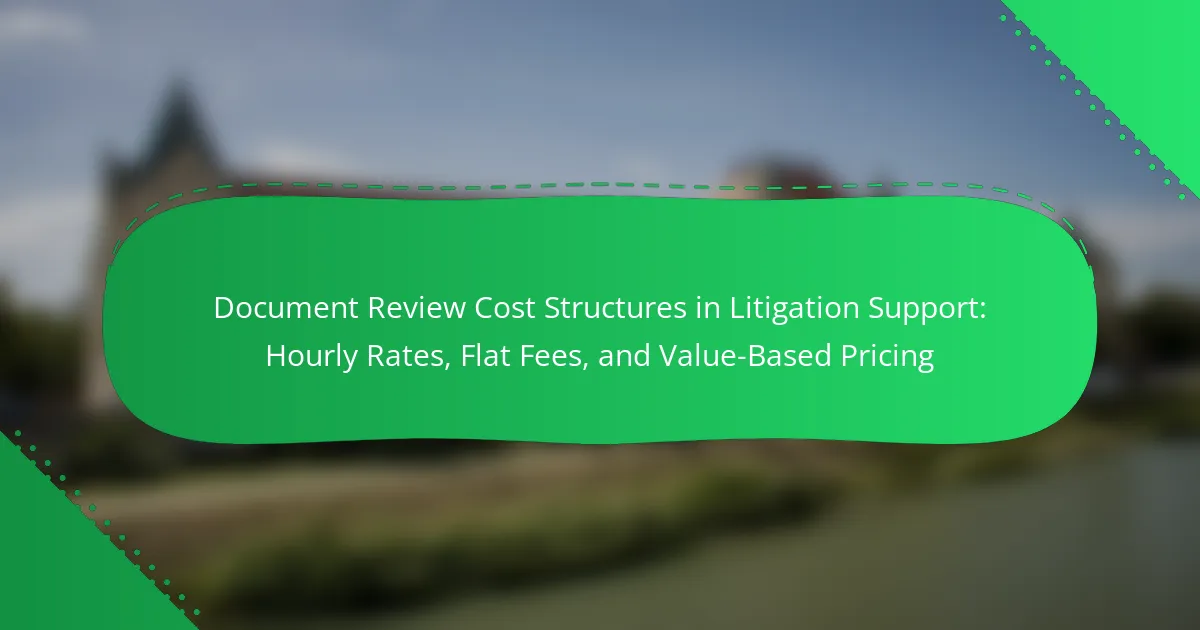Document Review Services are essential in litigation for the systematic examination of legal documents, focusing on identifying relevant information crucial for case preparation. These services enhance efficiency and accuracy by utilizing advanced technology and skilled professionals, significantly reducing manual review time and improving case outcomes. Best practices for effective utilization include defining objectives, selecting qualified providers, establishing structured workflows, leveraging technology, maintaining communication, and implementing quality control measures. By streamlining the review process, Document Review Services contribute to better-prepared cases and ultimately lead to more favorable litigation results.
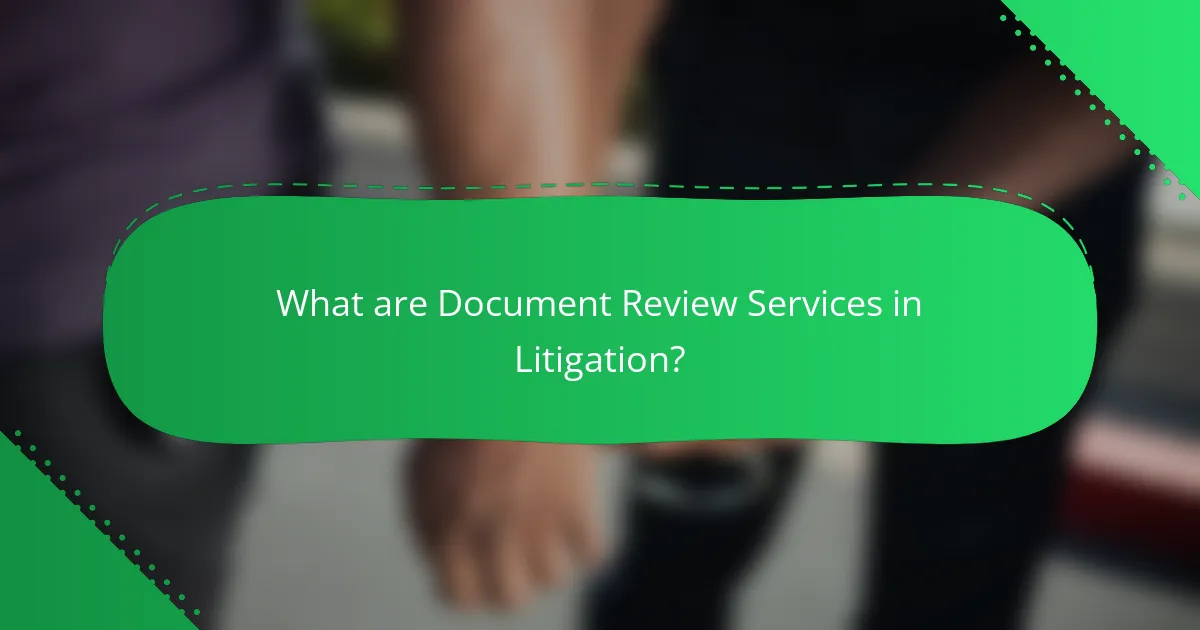
What are Document Review Services in Litigation?
Document review services in litigation involve the systematic examination of legal documents. These services are essential for identifying relevant information for cases. Legal professionals utilize these services to ensure compliance and accuracy. Document review can include sorting, organizing, and summarizing documents. This process helps in preparing for depositions and trials. It often employs technology for efficiency and accuracy. Many law firms outsource these services to specialized vendors. This approach can lead to cost savings and improved case outcomes.
How do Document Review Services function in legal cases?
Document review services function by systematically analyzing and organizing legal documents for litigation. These services employ trained professionals to evaluate large volumes of documents. The goal is to identify relevant information for a case. Reviewers categorize documents based on legal relevance, privilege, and confidentiality. This process ensures compliance with legal standards and reduces the risk of oversight. Document review services often utilize technology to enhance efficiency. For instance, software tools can assist in sorting and searching documents quickly. This approach saves time and reduces costs associated with manual review. Legal teams benefit from focused insights provided by these services.
What are the key processes involved in Document Review Services?
The key processes involved in Document Review Services include document collection, analysis, and categorization. Document collection involves gathering all relevant documents from various sources. This includes electronic files, physical documents, and emails. Analysis follows, where reviewers assess the content for relevance and privilege. Categorization involves organizing documents into specific groups based on criteria like relevance, confidentiality, or importance. Quality control is also essential, ensuring the accuracy of the review process. Finally, reporting summarizes findings and assists in decision-making. These processes enhance efficiency and accuracy in legal reviews.
How do technology and human resources collaborate in Document Review Services?
Technology and human resources collaborate in Document Review Services by integrating advanced software tools with skilled personnel. Technology streamlines the document review process through automation and artificial intelligence. This reduces manual effort and speeds up the review cycle. Human resources provide expertise in evaluating and interpreting complex legal documents. They ensure that the technology is used effectively and aligns with legal standards. Together, they enhance accuracy and efficiency in document handling. Studies show that firms utilizing this collaboration can achieve up to 30% faster review times. This synergy ultimately leads to cost savings and improved litigation outcomes.
What are the primary benefits of utilizing Document Review Services?
The primary benefits of utilizing Document Review Services include cost efficiency, enhanced accuracy, and significant time savings. Document Review Services streamline the review process, reducing labor costs by employing specialized technology and trained professionals. This approach minimizes human error, leading to higher accuracy in identifying relevant documents. Additionally, these services expedite the review timeline, allowing legal teams to focus on strategy rather than administrative tasks. Research indicates that firms using these services can decrease document review costs by up to 30%. This efficiency helps in meeting tight deadlines in litigation scenarios.
How does cost efficiency manifest in Document Review Services?
Cost efficiency in Document Review Services manifests through reduced labor costs and streamlined processes. Automated tools minimize the need for extensive manual review. This leads to faster completion times for document analysis. According to a study by the American Bar Association, outsourcing document review can save up to 30% in costs compared to in-house teams. Additionally, utilizing technology for e-discovery reduces the volume of documents needing review, further cutting expenses. Overall, these services provide significant savings while maintaining accuracy and thoroughness in litigation processes.
What role does accuracy play in the effectiveness of Document Review Services?
Accuracy is crucial for the effectiveness of Document Review Services. High accuracy ensures that relevant documents are identified and reviewed correctly. This reduces the risk of missing critical evidence in litigation. Accurate document reviews lead to better-informed legal strategies. Furthermore, accuracy minimizes the chances of errors that could result in costly legal repercussions. Studies show that inaccuracies can increase litigation costs by up to 30%. Therefore, maintaining accuracy enhances overall efficiency and effectiveness in the legal process.
How do Document Review Services contribute to time savings in litigation?
Document Review Services significantly contribute to time savings in litigation by streamlining the document analysis process. These services utilize advanced technology and skilled professionals to quickly sift through large volumes of documents. This reduces the time attorneys spend on manual review.
Moreover, Document Review Services can prioritize relevant documents based on specific case criteria. This targeted approach accelerates the identification of key evidence. As a result, legal teams can focus on strategy rather than document management.
Statistics show that using specialized document review can reduce review time by up to 50%. This efficiency allows for quicker case preparation and potentially faster resolution. By minimizing time spent on document review, legal professionals can allocate resources to other critical aspects of litigation.
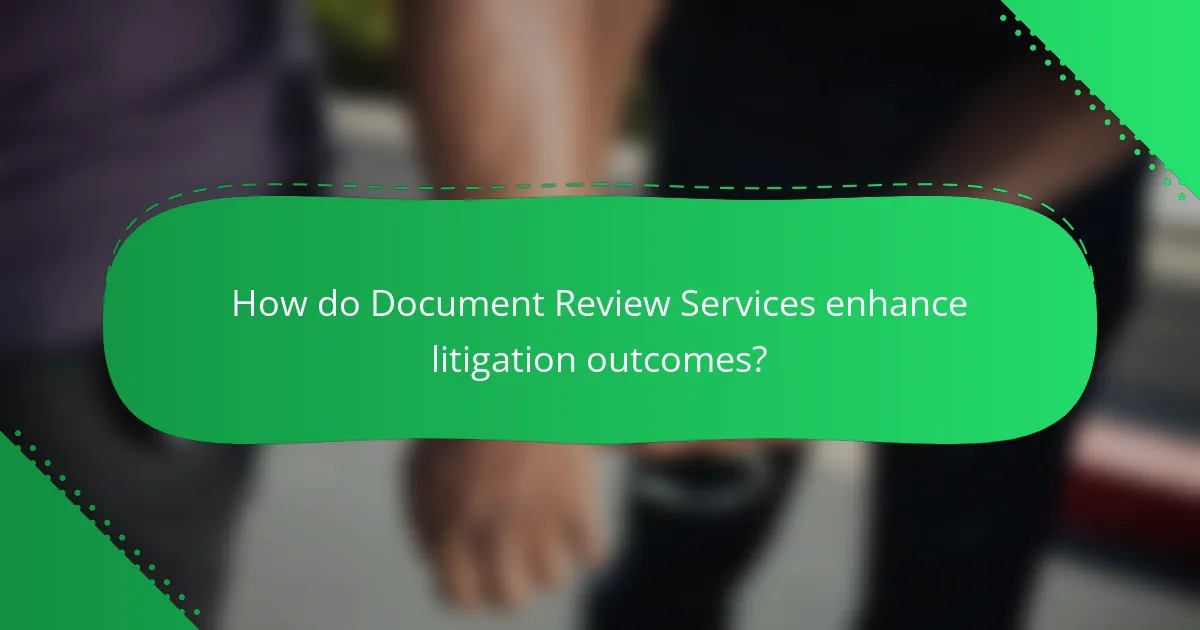
How do Document Review Services enhance litigation outcomes?
Document Review Services enhance litigation outcomes by increasing efficiency and accuracy in the review process. These services utilize advanced technology and skilled professionals to analyze large volumes of documents. This reduces the time spent on manual reviews, allowing legal teams to focus on strategy and case development. Studies show that employing document review services can decrease review time by up to 50%. Additionally, these services help identify relevant evidence more effectively, ensuring that critical information is not overlooked. By streamlining the review process, Document Review Services ultimately lead to better-prepared cases and improved litigation results.
What impact do Document Review Services have on case preparation?
Document Review Services significantly enhance case preparation by improving efficiency and accuracy. These services streamline the process of sorting through large volumes of documents. They utilize advanced technology to identify relevant information quickly. This reduces the time lawyers spend on manual document review. According to a study by the American Bar Association, efficient document review can decrease preparation time by up to 30%. Additionally, these services minimize the risk of human error. Accurate document analysis ensures that critical evidence is not overlooked. Overall, Document Review Services contribute to a more thorough and effective case preparation process.
How does thorough document review influence the success of litigation strategies?
Thorough document review significantly enhances the success of litigation strategies. It ensures that all relevant evidence is identified and organized. This process aids in building a strong case by highlighting key facts and supporting arguments. Accurate document review minimizes the risk of overlooking critical information. It also facilitates better communication among legal teams by providing a clear understanding of the case. Moreover, thorough review helps in anticipating opposing arguments and preparing counter-strategies. Studies show that well-prepared cases have a higher success rate in litigation outcomes. For instance, a report by the American Bar Association indicates that 70% of successful litigations stem from comprehensive document analysis.
What are the risks of neglecting document review in legal proceedings?
Neglecting document review in legal proceedings can lead to significant risks. One major risk is the potential for missing critical evidence. This oversight can undermine a case’s strength. Another risk is exposing the client to legal penalties. Failure to comply with discovery rules can result in sanctions. Additionally, neglecting document review can lead to increased litigation costs. Poorly managed documents often require more time and resources to rectify. Furthermore, the opposing party may gain an advantage. This can result from the lack of thorough preparation. Overall, neglecting document review compromises the integrity of the legal process.
What are the challenges associated with Document Review Services?
Document review services face several challenges. One significant challenge is the volume of documents to be reviewed. Legal cases can involve thousands of documents, making the process time-consuming. Another challenge is ensuring accuracy in the review process. Human error can lead to missed critical information. Additionally, maintaining confidentiality and data security is crucial. Breaches can have severe legal repercussions. Cost management is also a challenge, as high-quality review services can be expensive. Finally, adapting to evolving technology and tools for document review can be difficult for some firms. These factors collectively impact the efficiency and effectiveness of document review services.
How can firms address common challenges in document review processes?
Firms can address common challenges in document review processes by implementing advanced technology and best practices. Utilizing artificial intelligence tools can significantly speed up the review process. These tools can analyze large volumes of documents quickly and accurately. Additionally, firms should establish clear protocols for document organization. This can reduce confusion and improve efficiency during the review. Training staff on the latest document review software is also essential. Well-trained personnel can minimize errors and enhance productivity. Regularly assessing the review process for bottlenecks can help identify areas for improvement. By adopting these strategies, firms can enhance the effectiveness of their document review processes.
What are the implications of poor document review on litigation results?
Poor document review can severely impact litigation results. It may lead to missed evidence, which can weaken a case. Inaccurate or incomplete reviews can result in unfavorable judgments. Additionally, poor reviews often increase litigation costs due to the need for rework. A study by the American Bar Association found that 70% of attorneys believe document review errors can alter case outcomes. Inefficient document handling can also extend the timeline of litigation, causing delays in resolution. Ultimately, these implications highlight the necessity of thorough document review processes.
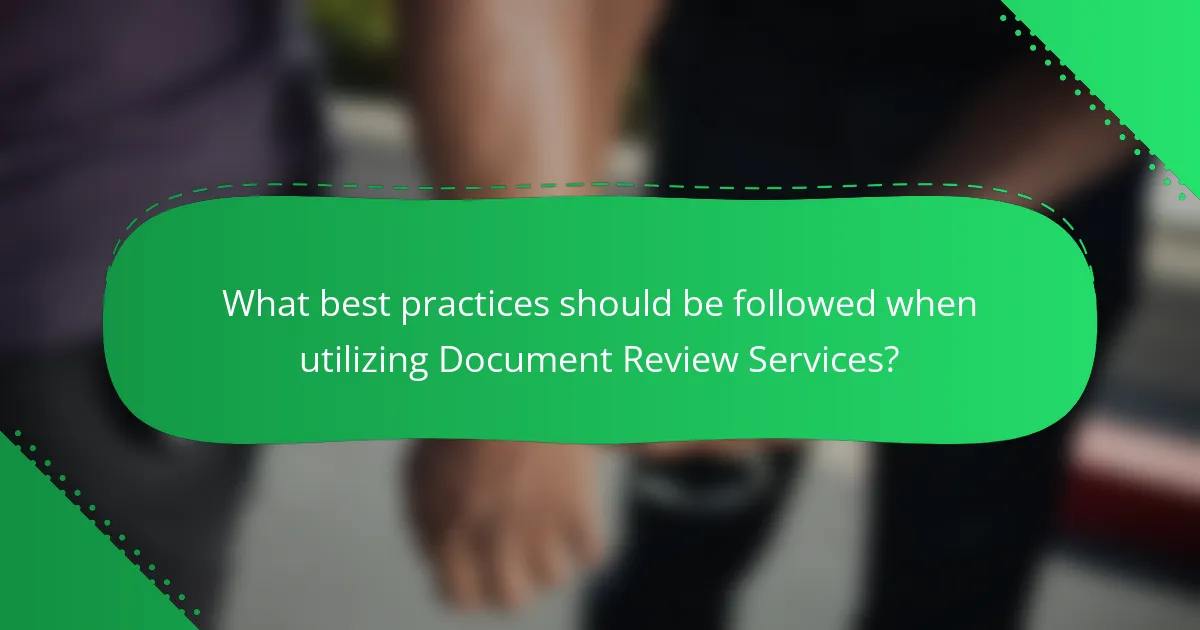
What best practices should be followed when utilizing Document Review Services?
Utilizing Document Review Services effectively requires adherence to several best practices. First, clearly define the objectives of the document review. This includes understanding the scope and key issues involved in the case. Second, select a qualified service provider with expertise in the relevant legal field. A provider with a proven track record enhances accuracy and efficiency. Third, establish a well-structured workflow. This ensures that documents are reviewed systematically and consistently. Fourth, utilize technology to streamline the review process. Advanced software can enhance searchability and categorization of documents. Fifth, maintain open communication with the review team. Regular updates can help address issues and adjust strategies as needed. Lastly, implement quality control measures. This includes periodic audits to ensure the review meets established standards. Following these practices can significantly improve the outcomes of utilizing Document Review Services in litigation.
How can legal teams maximize the efficiency of Document Review Services?
Legal teams can maximize the efficiency of Document Review Services by implementing advanced technology and structured processes. Utilizing artificial intelligence (AI) tools can significantly speed up the review process. AI can quickly analyze large volumes of documents, identifying relevant information and reducing manual labor.
Additionally, establishing clear guidelines and criteria for document review enhances consistency in evaluations. Training team members on these guidelines ensures everyone understands the standards expected. Regular communication among team members fosters collaboration and addresses any issues promptly.
Moreover, prioritizing documents based on relevance can streamline the review process. This targeted approach helps teams focus on the most critical documents first. Tracking metrics related to review speed and accuracy allows teams to identify areas for improvement.
Finally, leveraging external expertise when necessary can fill gaps in knowledge or resources. Engaging specialized document review services can provide additional support during peak workloads. Together, these strategies lead to a more efficient document review process, ultimately saving time and costs in litigation.
What tools and technologies can enhance the document review process?
Artificial intelligence tools can enhance the document review process. These tools automate the identification of relevant documents. They use machine learning algorithms to improve accuracy over time. Predictive coding is a common feature in these tools. This technology helps prioritize documents based on relevance. Natural language processing (NLP) is also utilized for better understanding of content. Document management systems streamline the organization of files. Collaboration platforms facilitate communication among reviewers. Analytics tools provide insights into review progress and efficiency.
How can legal professionals ensure the accuracy of document reviews?
Legal professionals can ensure the accuracy of document reviews by implementing systematic verification processes. These processes include cross-referencing documents with original sources. Utilizing technology, such as document review software, aids in identifying discrepancies. Regular training for team members on best practices enhances their review skills. Peer reviews within the team provide additional oversight and catch errors. Establishing clear guidelines for document review creates consistency in evaluations. Documenting the review process ensures accountability and traceability of decisions. Studies show that structured approaches significantly reduce errors in legal document reviews.
What are the future trends in Document Review Services for litigation?
Future trends in Document Review Services for litigation include increased automation and the use of artificial intelligence. These technologies enhance efficiency by quickly processing large volumes of documents. Predictive coding is becoming more common, allowing for quicker identification of relevant information. Additionally, remote document review is on the rise, driven by the flexibility of virtual teams. The integration of cloud-based tools is facilitating better collaboration among legal professionals. Enhanced data security measures are also being prioritized to protect sensitive information. Overall, these trends aim to improve cost efficiency, accuracy, and time savings in the document review process.
How is artificial intelligence shaping the future of document review?
Artificial intelligence is transforming document review by enhancing efficiency and accuracy. AI technologies can process vast amounts of data quickly. They utilize machine learning algorithms to identify relevant documents. This reduces the time needed for manual review significantly. Studies show that AI can achieve over 90% accuracy in document classification. This level of precision minimizes the risk of human error. Additionally, AI can analyze patterns in data that humans might overlook. As a result, organizations can save on labor costs and expedite the litigation process.
What emerging technologies should legal professionals be aware of?
Legal professionals should be aware of artificial intelligence, blockchain, and predictive analytics. Artificial intelligence enhances document review efficiency and accuracy. AI tools can analyze vast amounts of data quickly. Blockchain ensures secure and transparent transactions in legal agreements. It provides an immutable record of contracts. Predictive analytics helps in case outcome forecasting. These technologies can improve decision-making and strategy formulation. According to a report by the International Legal Technology Association, 75% of firms are adopting AI tools. This trend indicates a significant shift towards technology integration in legal practices.
Document Review Services in litigation are essential for systematically examining legal documents to identify relevant information for cases, ensuring compliance and accuracy. This article outlines the benefits of utilizing these services, including cost efficiency, enhanced accuracy, and significant time savings. Key processes such as document collection, analysis, and categorization are discussed, alongside the collaboration of technology and human resources to improve efficiency. Additionally, the article highlights the implications of poor document review, best practices for effective utilization, and future trends in the field, emphasizing the importance of thorough document review for successful litigation outcomes.
